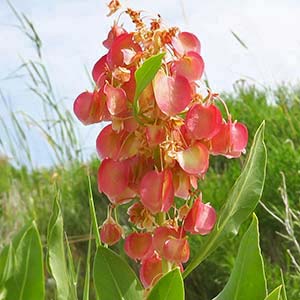Rumex venosus
Rumex pallidus
rumex veine, vein dock, veiny dock, wild-begonia, wing dock
seabeach dock, seaside dock, seaside or pale willow dock
ascending or, rarely, erect, usually producing axillary shoots near base, (10–)15–30(–40) cm.
ascending or erect occasionally almost procumbent, usually producing axillary shoots below 1st-order inflorescence or at proximal nodes, 30–60(–80) cm.
blades ovate-elliptic, obovate-elliptic, or ovate-lanceolate, (2–)4–12(–15) × 1–5(–6) cm, subcoriaceous, base narrowly to broadly cuneate, margins entire, flat or slightly undulate, apex acute or acuminate.
blades linear-lanceolate, 10–20(–22) × 1–3.5(–4.5) mm, usually ca. 7–10 times as long as wide, widest near middle, thick, coriaceous, base cuneate, margins entire, flat or slightly undulate, apex acute.
terminal and axillary, usually occupying distal 2/3 of stem/shoot, usually dense, or interrupted in proximal part, broadly paniculate.
terminal and axillary, terminal usually occupying distal 1/5–1/3 of stem, rather dense or interrupted in proximal 1/2, usually broadly paniculate (distal branches simple, proximal ones usually with few 2d-order branches).
articulated near middle, filiform or slightly thickened, (8–)10–16 mm, articulation distinct, slightly swollen.
articulated in proximal 1/3 or almost near base, filiform, 4–6 mm, not more than 2–2.5 times as long as inner tepals, articulation indistinctly swollen.
5–15 in whorls;
inner tepals distinctly double-reticulately veined, orbiculate or reniform-orbiculate, 13–18(–20) × (20–)23–30 mm, base deeply emarginate or cordate, margins entire, apex rounded, obtuse, rarely subacute, with short, broadly triangular tip;
tubercles absent, occasionally very small.
10–20 in whorls;
inner tepals, broadly ovate-triangular or almost deltoid, occasionally broadly triangular, (2.5–)3–4 × 2–3.5 mm, base truncate or round, occasionally indistinctly cordate, margins entire or indistinctly erose, apex obtuse or subacute;
tubercles 3, equal or subequal, all tubercles, or at least largest tubercle pale, subequal to inner tepals or slightly narrower than inner tepals, often minutely verrucose.
brown or dark brown, 5–7 × 4–6 mm.
brown or dark reddish brown, 2–3 × 1–1.5 mm.
= 40.
= 20.
Rumex venosus
Rumex pallidus
Rumex venosus is a distinctive species rarely confused with any other members of the genus. However, I have seen herbarium specimens of it misidentified as R. hymenosepalus, and vice versa.
(Discussion copyrighted by Flora of North America; reprinted with permission.)
Rumex pallidus is restricted to northeastern North America. Specimens with more “strict habit, larger leaves, and more erect fruiting branches” reported by K. H. Rechinger (1937) from Alaska and Yukon as this species belong instead to R. sibiricus (E. Hultén 1941–1950, vol. 4). Those species, as well as R. subarcticus and R. hultenii Tzvelev, represent a rather natural northern group of the R. salicifolius aggregate. The hybrid R. pallidus × R. triangulivalvis was reported from the western part of New York (R. S. Mitchell 1986).
(Discussion copyrighted by Flora of North America; reprinted with permission.)
- Local floras:
CA,
OR,
WA
- Local Web sites:
CalFlora,
CalPhotos,
Flora NW,
KS Wildflowers,
MN Wildflowers,
PNW Herbaria,
Turner Photog.
WildflowerSearch
iNaturalist (observations)
USDA Plants Database
- LBJ Wildflower Center
- SEINet
- Plants of the World Online
- Encyclopedia of Life
- Wikipedia
- Google Image Search


